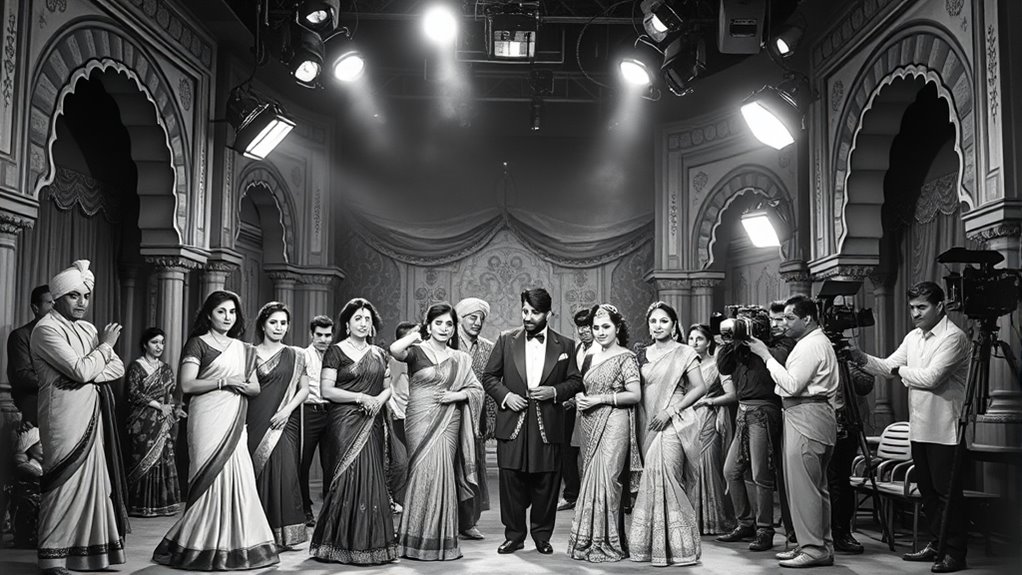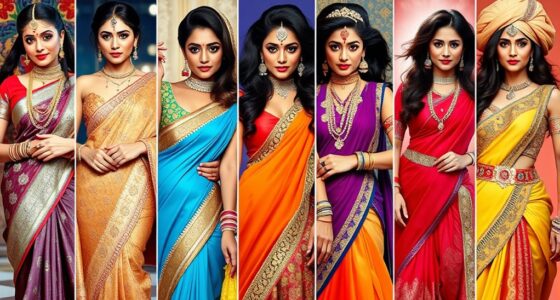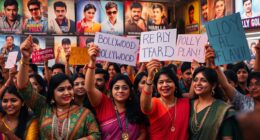During Bollywood’s golden age from the 1950s–60s, you’ll find classic films like *Mother India*, *Mughal-e-Azam*, *Awaara*, and *Pyaasa* that revolutionized storytelling, visuals, and emotional depth. These movies reflect India’s cultural, social, and historical complexities, showcasing themes of resilience, love, and societal critique. Their innovative techniques and iconic music still influence Indian cinema today. If you explore further, you’ll discover even more cinematic treasures from this remarkable era.
Key Takeaways
- Iconic films like *Mother India*, *Awaara*, *Pyaasa*, *Mughal-e-Azam*, and *Gunga Jumna* define Bollywood’s golden age with their storytelling and visuals.
- These classics showcase innovative cinematic techniques, elaborate set designs, and memorable music that influenced Indian filmmaking.
- Themes of resilience, societal struggles, love, and duality reflect India’s cultural identity during the 1950s–60s.
- Directors like Mehboob Khan and Raj Kapoor pioneered visual storytelling, blending social commentary with artistic experimentation.
- The films set historical standards, combining emotional depth, aesthetic grandeur, and cultural symbolism of India’s post-independence era.
Mother India (1957)
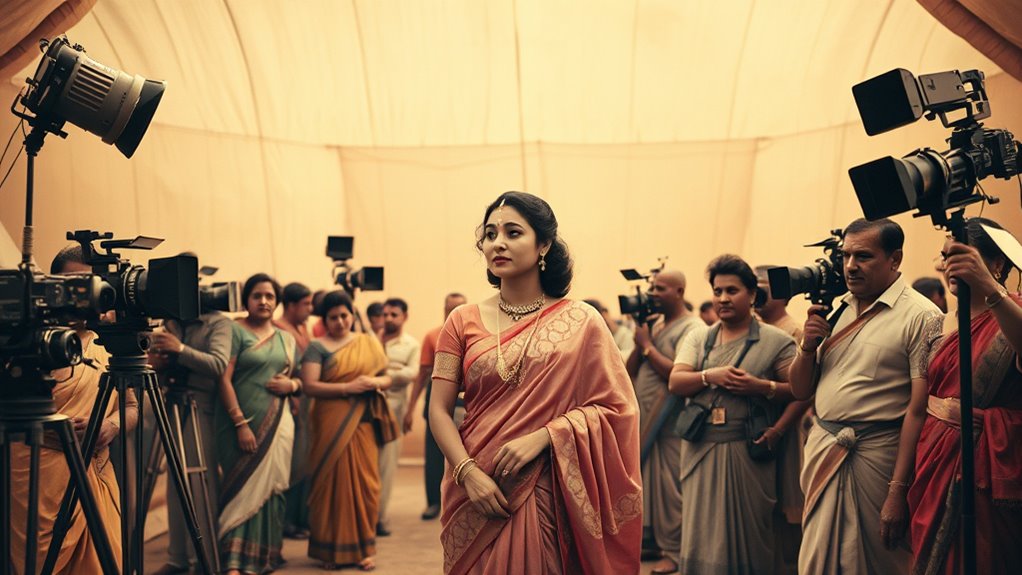
Emerging as a landmark in Indian cinema, Mother India (1957) captures the struggles and resilience of a rural woman facing overwhelming hardships. You witness Radha’s unwavering strength as she fights poverty, betrayal, and natural disasters to protect her family. Directed by Mehboob Khan, the film portrays her sacrifices amid adverse circumstances, including her husband’s departure and the death of her youngest son. Suffering under the exploitation of the cunning moneylender Sukhilala, Radha embodies moral integrity and endurance. Her character, played powerfully by Nargis, symbolizes the spirit of motherhood and Indian village life. The film’s emotional depth and compelling storytelling earned it worldwide recognition, making it the first Indian movie nominated for an Oscar. It was also the first Indian film to be nominated for the Academy Award for Best International Feature Film, and Mother India’s legacy endures as an iconic depiction of resilience and moral virtue.
Awaara (1951)
You’ll see how Raj Kapoor’s signature style shines through in “Awaara,” blending bold storytelling with memorable visuals. The film explores themes of duality—good versus evil and social divides—that resonate deeply with audiences. Its musical masterpieces not only enhance the narrative but also cement its place as a timeless classic of Bollywood. Additionally, the film’s innovative use of musical storytelling set new standards for Indian cinema. The film’s visual style also benefits from thoughtful cinematography techniques that elevate its artistic impact, incorporating elements of music therapy integration to deepen emotional engagement with viewers.
Raj Kapoor’s Signature Style
Raj Kapoor’s signature style in *Awaara* revolutionized Bollywood cinema by seamlessly blending social commentary with innovative cinematic techniques. You’ll notice how he combines drama, music, and dance to create emotionally charged storytelling. His direction emphasizes character development, especially the protagonist’s struggle between two worlds, reflecting post-colonial India’s hopes and challenges. Kapoor’s use of inventive camera work and complex narrative structures kept viewers engaged. He also integrated sound and music to heighten emotional impact, making each scene resonate deeply. The film’s visual style, from costumes to settings, showcases meticulous attention to detail. By doing so, Kapoor not only crafted a compelling story but also set a new standard for cinematic storytelling in Bollywood, influencing generations of filmmakers. His ability to merge social messages with entertainment also helped elevate Bollywood’s global reputation. Additionally, Kapoor’s innovative approach to storytelling often incorporated cinematic techniques, which enhanced the emotional depth and visual appeal of his films. Moreover, his emphasis on visual storytelling contributed significantly to his distinctive directorial style, inspiring future filmmakers worldwide.
Themes of Duality
In *Awaara*, the theme of duality forms the core of the film’s narrative, illustrating the stark contrasts within Indian society. You see this through the dichotomy of rural versus urban life, exposing societal disparities and the lure of social mobility. Raj’s moral conflict reflects his struggle between the slums and the desire for respectability with Rita. The film also employs symbolic imagery, like the dream sequence contrasting hellish street life with heavenly aspirations, highlighting social fantasies. Raj’s dual identity, shaped by family dynamics and environment, underscores the fight between innocence and corruption. Through visual storytelling and social critique, *Awaara* captures the tension between tradition and modernity, poverty and prosperity, revealing the complex layers of Indian societal duality.
Musical Masterpieces
- The song “Awaara Hoon” became an international hit, symbolizing hope and resilience.
- The soundtrack’s fusion of traditional and modern styles set a new standard.
- Singers like Mukesh, Lata Mangeshkar, and Mohammed Rafi brought depth to the songs.
- Its social themes and musical innovation influenced generations of Bollywood films.
- The film’s musical diversity showcased a range of styles that appealed to diverse audiences worldwide, highlighting the importance of cultural influences in shaping Bollywood’s golden era.
- Additionally, the innovative use of orchestration and blending of genres reflected the evolving musical landscape of India during that time, emphasizing the significance of musical innovation in creating timeless classics.
Pyaasa (1957)
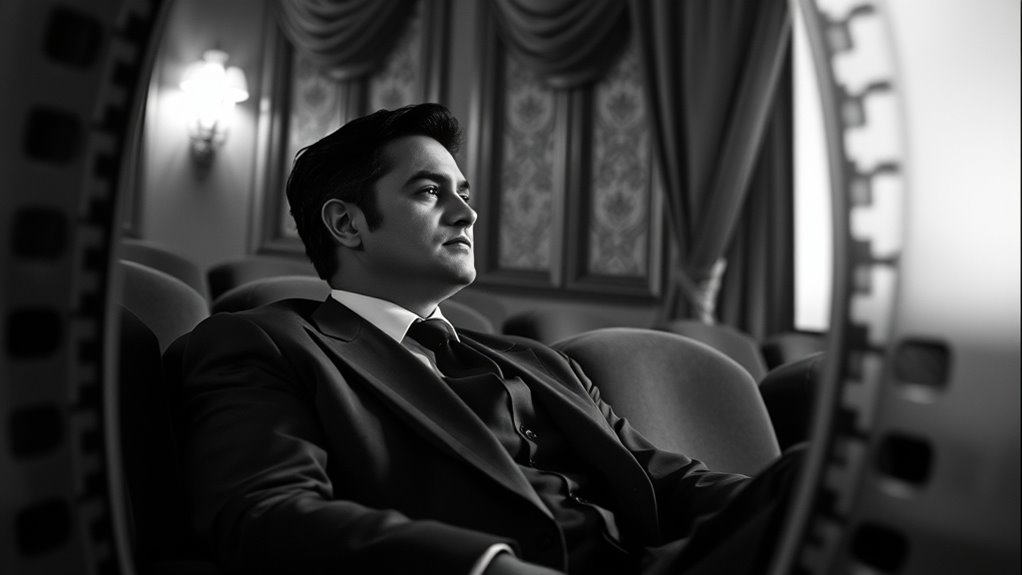
Have you ever wondered how a film can mirror society’s deepest struggles and aspirations? Pyaasa (1957) does just that. You follow Vijay, an idealistic Urdu poet rejected for writing about social issues, not romance. His encounters with Gulabo, a compassionate prostitute, and Meena, his materialistic ex-girlfriend, highlight societal hypocrisy. When a beggar wearing Vijay’s coat dies, he’s mistaken for dead, and his poetry gains fame posthumously. Vijay’s return, rejection, and escape from an asylum symbolize society’s neglect of truth and talent. The film critiques materialism, corruption, and marginalization, blending personal pain with social commentary. Through poetic storytelling, striking visuals, and memorable music, Pyaasa captures the essence of India’s post-independence struggles and remains a cinematic masterpiece.
Mughal-e-Azam (1960)
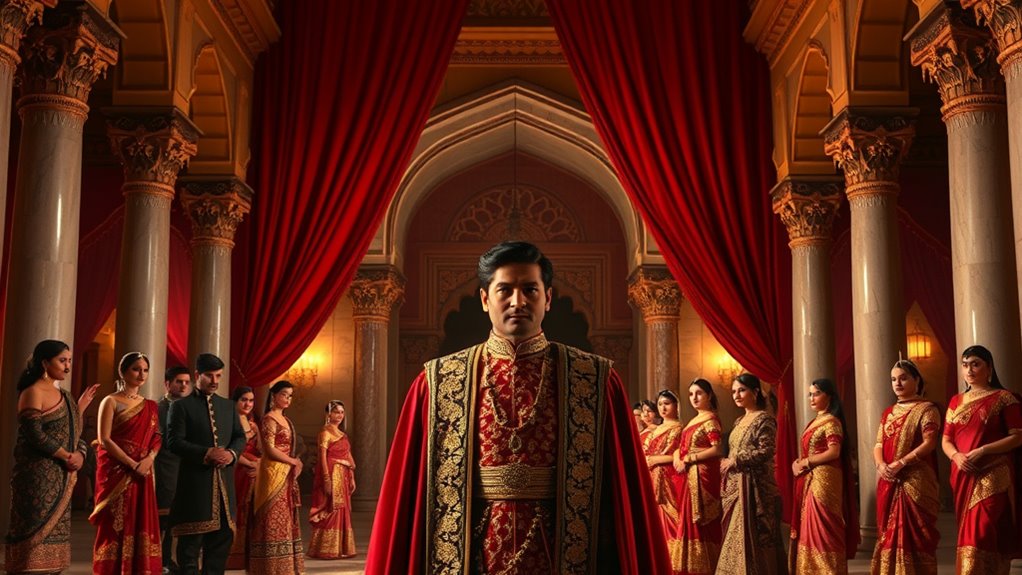
You’ll notice how Mughal-e-Azam masterfully combines a grand historical narrative with stunning visual spectacle and intricate art. The film’s romantic drama elements draw you into the intense love story of Salim and Anarkali, set against opulent Mughal backdrops. It exemplifies the Golden Age’s signature style, blending storytelling, visuals, and emotion seamlessly. Additionally, its portrayal of relationships highlights the importance of understanding and emotional depth in storytelling. The film’s artistic craftsmanship and attention to detail exemplify the period’s dedication to cinematic excellence, reflecting the period’s emphasis on visual spectacle and meticulous set design.
Grand Historical Narrative
What makes Mughal-e-Azam a quintessential example of a grand historical narrative is its meticulous portrayal of the Mughal Empire’s rich and tumultuous history. You witness the complex relationship between Emperor Akbar and his son Salim, grounded in historical facts about power struggles and family dynamics. The film’s setting during the 16th century allows you to explore themes like rebellion, love, and duty. It vividly depicts key figures such as Akbar, Salim, Anarkali, and Jodha, emphasizing their roles in shaping history. The narrative structure follows Salim’s growth from a reckless prince to a warrior, culminating in his conflict with his father. This epic storytelling captures the grandeur and emotional depth of the era, making it a hallmark of historical cinema. Additionally, the film’s authentic historical backdrop is supported by elaborate costumes and set designs that reflect the grandeur of the Mughal era. The use of historical accuracy in costumes and architecture further immerses viewers into the period’s splendor and authenticity. Furthermore, the film’s portrayal of political intrigue and personal sacrifice exemplifies the cultural significance of the Mughal period in Indian history. Incorporating cultural context enhances the narrative’s depth and educational value.
Visual Spectacle & Art
Mughal-e-Azam’s visual spectacle is legendary, showcasing an extraordinary level of craftsmanship and imagination that set new standards for Indian cinema. You’ll notice the stunning set designs inspired by Mughal architecture, especially in the Sheesh Mahal, which transformed production design. The film’s rich color and cinematography, including the Technicolor dance scene “Pyar Kiya To Darna Kya,” broke new ground visually. As the most expensive Indian film of its time, its elaborate backdrops and real Mughal palaces created an immersive experience. Innovative camera work and meticulous art direction, led by M. K. Syed, added grandeur and authenticity. The film’s visuals, combined with lavish costumes and jewelry, elevated Indian cinema’s aesthetic, influencing countless future productions and establishing Mughal-e-Azam as a true visual masterpiece. Additionally, the film’s visual effects contributed to its lasting impact on Indian filmmaking, demonstrating the importance of production design in creating a memorable cinematic experience.
Romantic Drama Elements
The film’s romantic drama elements are driven by a powerful conflict between love and duty, creating an intense emotional core. You see Prince Salim’s passionate love for Anarkali clash with his father Emperor Akbar’s strict social rules. This forbidden romance fuels rebellion, heightening the tragedy. The emotional intensity is amplified through heightened language and powerful expressions, making you feel every heartbreak. Key aspects include:
- Class Divide – Anarkali’s lower status versus Salim’s royal birth highlights social barriers.
- Rebellion – Salim’s defiance becomes a symbol of personal freedom against authority.
- Sacrifice – Anarkali’s willingness to suffer for love deepens the tragedy.
- Music and Lyrics – Songs like “Pyar Kiya To Darna Kya” accentuate longing, passion, and despair.
- Emotional Expression – The film’s use of heightened language and expressions intensifies the emotional impact, drawing viewers deeply into the characters’ inner turmoil. Additionally, the use of powerful dialogue enhances the emotional resonance of pivotal scenes. The incorporation of advanced film techniques also contributes to creating an immersive emotional experience. Recognizing these elements can deepen viewers’ appreciation for how classic films masterfully evoke emotional engagement.
Shree 420 (1955)

Released in 1955, *Shree 420* stands as a quintessential example of Bollywood’s Golden Age, blending social commentary with memorable music and compelling storytelling. You follow Raj, a naive orphan who moves to Bombay, seeking a better life. His journey takes a dark turn as he gets involved in crime, lured by promises of wealth from unscrupulous businessman Seth Sonachand Dharmanand. Along the way, Raj meets Vidya, a virtuous woman who loves him, and faces moral dilemmas that challenge his integrity. The film explores themes of morality, corruption, and redemption, reflecting post-independence India’s social struggles. With Raj Kapoor’s direction, soulful music by Shankar-Jaikishan, and powerful performances, *Shree 420* captures the hopes and disillusionments of the common man, earning its iconic status.
Gunga Jumna (1961)
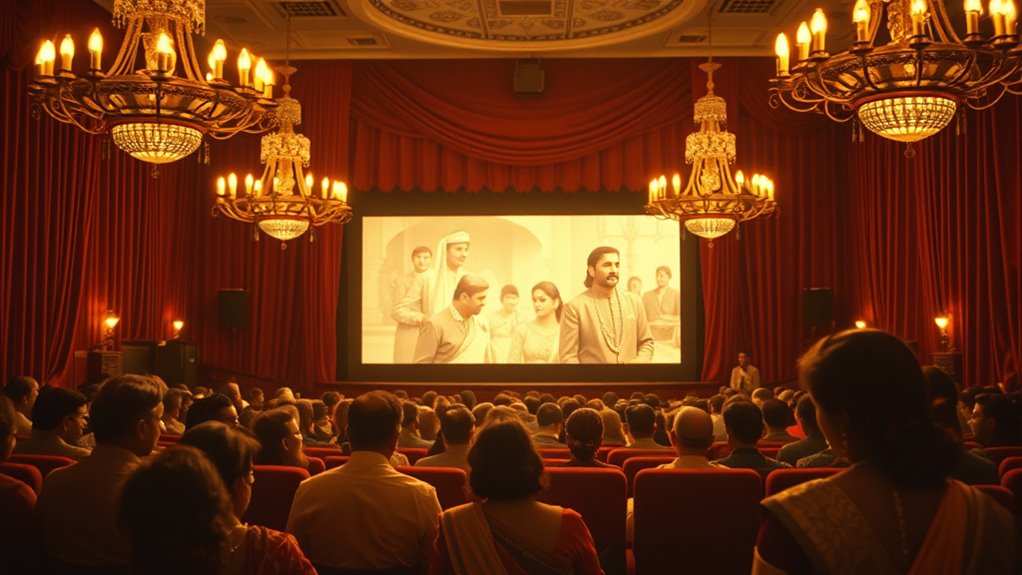
Gunga Jumna, a 1961 film directed by Nitin Bose with Dilip Kumar as the ghost director, stands out as a powerful portrayal of sibling rivalry set in rural Awadh. You’ll notice how the film explores themes of poverty, justice, and family loyalty through its intense story of two brothers on opposite sides of the law. The cast includes Dilip Kumar as Gunga and Nasir Khan as Jamna, with Vyjayanthimala in a supporting role. The film’s use of Awadhi dialect and Technicolor adds authenticity and visual appeal. Key highlights include:
A powerful 1961 film exploring sibling rivalry, loyalty, and justice in rural Awadh with memorable performances and vibrant Technicolor visuals.
- A compelling story of loyalty and conflict.
- Strong performances that elevate the narrative.
- Memorable music composed by Naushad.
- Its lasting influence on Indian cinema and the dacoit genre.
- The film’s cultural significance continues to be celebrated in Indian film history.
Additionally, the film’s direction and storytelling techniques are studied for their innovative approach during that era. Incorporating traditional musical elements further enhances its cultural richness and emotional depth. Recognizing the importance of filmmaking innovations, the film showcases how technical and narrative advancements contributed to its timeless appeal.
Gunga Jumna remains a cinematic milestone of India’s golden age.
Kaagaz Ke Phool (1959)
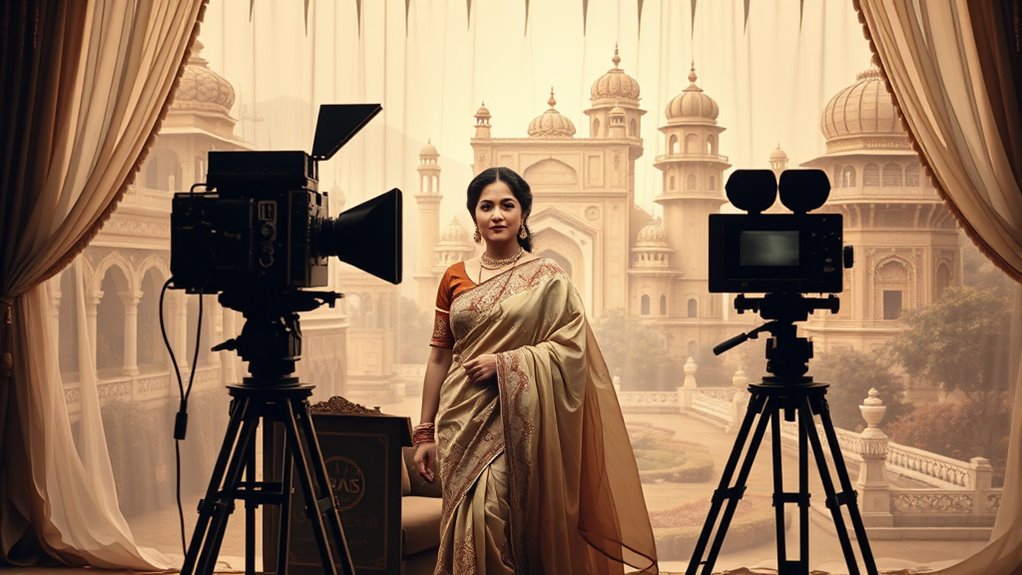
You can see Guru Dutt’s unique cinematic vision in *Kaagaz Ke Phool*, where his artistry transforms storytelling. The film’s melancholy tone and artistic style reveal his deep emotional expression and innovative techniques. Its impact on Indian cinema is profound, inspiring future filmmakers and elevating the art form.
Guru Dutt’s Cinematic Vision
What sets Guru Dutt’s cinematic vision apart is his ability to blend innovative technology with deep artistic expression. He pushed boundaries, using tools like CinemaScope to create expansive visuals that enhanced storytelling. His films, especially *Kaagaz Ke Phool*, combine technical mastery with poetic themes of love, societal pressures, and the film industry. You’ll notice his focus on visual storytelling through symbolism and emotional depth. Consider these key aspects:
- First Indian film shot in CinemaScope, broadening visual scope and grandeur.
- Self-reflexive storytelling, reflecting his personal disillusionment.
- Use of symbolism, conveying complex themes subtly.
- Cinematic pacing, expertly balancing emotional build-up with narrative flow.
Dutt’s vision continually challenged Indian cinema’s norms, making his work timeless.
Melancholy and Artistic Style
Kaagaz Ke Phool’s artistic style powerfully captures the pervasive melancholy that defines its narrative. You feel the sense of fleeting fame and tragic downfall through its somber tone, reflecting the protagonist’s disillusionment with success, love, and industry harshness. The film’s visuals, with diffused lighting and shadows, evoke loneliness, deepening emotional depth. Its innovative CinemaScope cinematography by VK Murthy emphasizes decay and nostalgia, supporting the film’s reflective mood. The narrative’s film-within-a-film structure parallels the protagonist’s inner turmoil, blending personal and professional failures. Guru Dutt’s performance as Suresh Sinha embodies introspection and tragedy, while Waheeda Rehman’s expressive acting conveys profound emotion. Overall, Kaagaz Ke Phool’s restrained dialogue, symbolic visuals, and autobiographical undertones create a haunting exploration of despair beneath glamorous façades.
Impact on Indian Cinema
Kaagaz Ke Phool’s artistic and thematic innovations left a lasting mark on Indian cinema. As you explore its influence, you’ll notice how it revolutionized filmmaking in several ways:
- Cinematic Innovation: It was India’s first cinemascope film, pushing technological boundaries.
- Realistic Portrayal: The narrative broke traditional molds, depicting life and the film industry authentically.
- Enduring Legacy: Despite initial setbacks, it’s now regarded as a timeless classic studied by scholars.
- Industry Critique: The film openly critiqued stardom and overlooked behind-the-scenes creators, challenging industry norms.
These elements shaped future filmmaking, inspiring directors to embrace realism, technical advancements, and self-reflexive storytelling, leaving an indelible imprint on Indian cinema’s evolution.
Pather Panchali (1955)
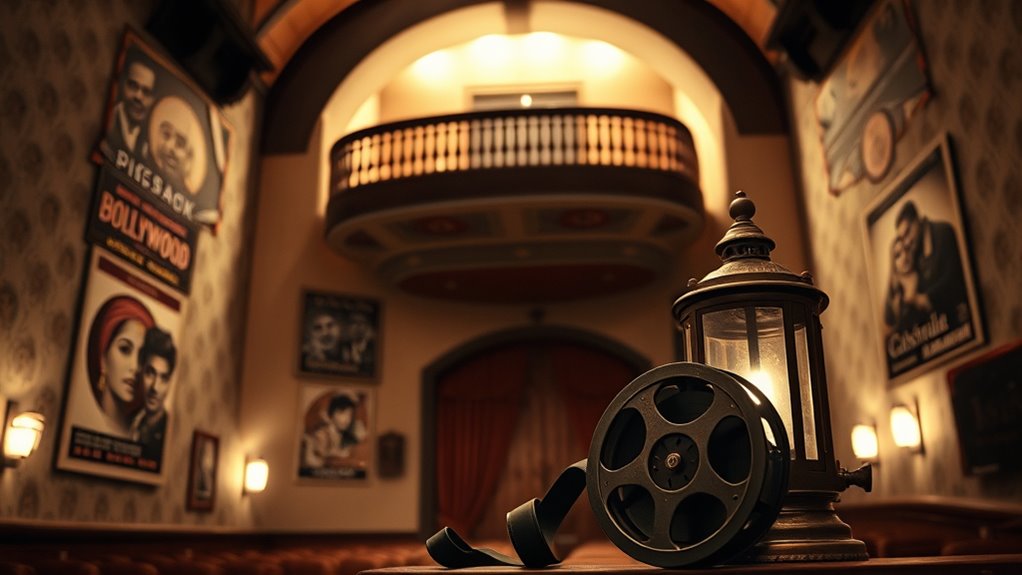
Pather Panchali (1955), the first film of The Apu Trilogy, masterfully portrays the childhood hardships of Apu and his sister Durga in rural Bengal. You see their family struggle with poverty, societal challenges, and emotional pain. Harihar, Apu’s father, is a writer and poet who leaves home for work, deepening their financial struggles. The film highlights their harsh realities, including illness and the death of their mother Indir and sister Durga, caused by poverty and disease. You notice how the film combines naturalistic visuals with poetic storytelling, capturing village life’s rhythm without melodrama. Its realistic approach, authentic locations, and non-professional actors influence Indian cinema profoundly, earning international acclaim and shaping the Golden Age of Bollywood.
Mughal-e-Azam (1960)

Mughal-e-Azam (1960) stands as a landmark in Indian cinema, showcasing the grandeur and artistry that defined Bollywood’s Golden Age. You’re transported to the late 16th century, where Prince Salim’s love for Anarkali sparks conflict with Emperor Akbar. The film’s epic storytelling, lavish sets, and vibrant costumes reflect its historical authenticity and technical brilliance. You’ll notice:
- Stunning use of color and elaborate set designs that bring the era to life
- Iconic music composed by Naushad, with songs that have stood the test of time
- Powerful performances by Dilip Kumar, Madhubala, and Prithviraj Kapoor
- Innovative cinematography and lighting techniques that enhance the grandeur
This film’s cultural impact and critical acclaim cement its status as a timeless classic in Indian cinema.
Gunga Jumna (1961)
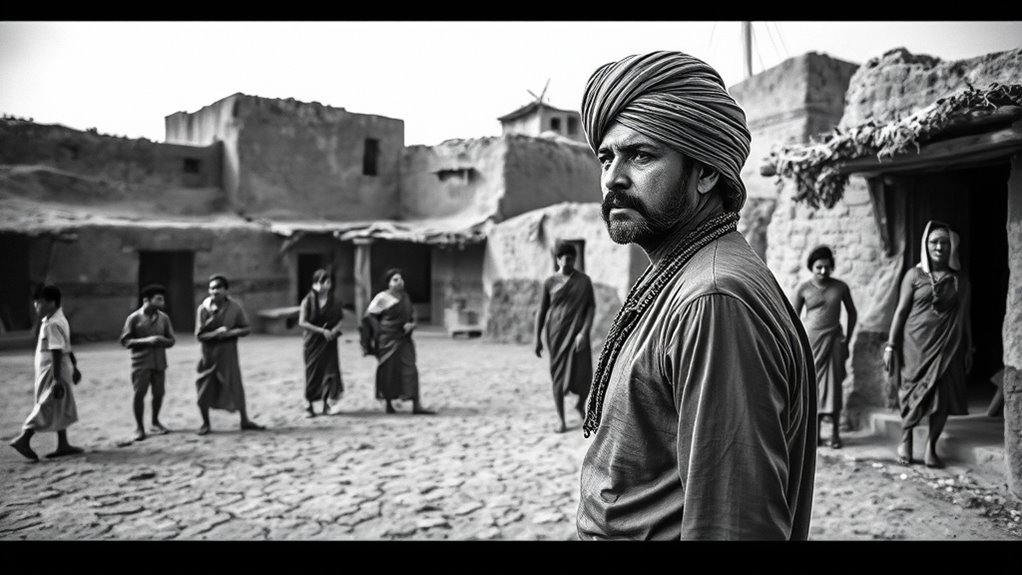
Released in 1961, Gunga Jumna stands out as a powerful example of Bollywood’s Golden Age, blending compelling storytelling with striking visuals. You follow the story of two brothers, Ganga and Jamna, raised in rural Awadh, who find themselves on opposite sides of the law. Gunga becomes an outlaw due to circumstances beyond his control, while Jamna joins the police. The film captures their intense sibling rivalry and explores themes of social injustice, poverty, and family loyalty. With Dilip Kumar delivering a legendary performance, the film’s visuals and music by Naushad elevate its emotional impact. Set in the rustic landscape, Gunga Jumna’s portrayal of rural India and its social issues make it a defining classic, celebrated for its storytelling and cultural significance.
Frequently Asked Questions
What Social Issues Are Most Prominently Depicted in Golden Age Films?
You notice that these films focus heavily on social issues like poverty, gender roles, communal tensions, and social reform. They vividly portray the struggles of the poor, women’s resilience, and the trauma of Partition, emphasizing unity and secularism. These movies also critique societal hypocrisies, highlight caste discrimination, and promote modernization, inspiring hope for a better, more equitable India. They serve as powerful reflections and calls for change within society.
How Did the Era Influence Modern Bollywood Storytelling Techniques?
You see that modern Bollywood storytelling still echoes Golden Age techniques. You’re likely to notice strong emotional narratives, memorable songs that push the plot, and social themes woven into stories. Filmmakers use innovative visuals, expressive framing, and grand set designs inspired by that era. Plus, multi-layered plots and balanced pacing create engaging movies. These elements help keep the universal appeal alive, blending tradition with modern technology for broader audience reach.
Which Actors From the Golden Age Are Still Celebrated Today?
You’ll find many actors from the golden age are still celebrated today. Dilip Kumar’s legendary method acting influences actors like Amitabh Bachchan. Raj Kapoor’s innovative storytelling and directorial style inspire filmmakers. Dev Anand’s charismatic presence remains iconic. Female stars like Madhubala and Meena Kumari are remembered for their timeless performances. Their contributions shaped Indian cinema, and their legacy endures through classic films, awards, and continued admiration by fans worldwide.
What Role Did Music Play in Shaping Golden Age Cinema?
Imagine streaming a classic film from the 1950s–60s without its memorable songs—you’d miss its soul. Music shaped golden age cinema by blending Indian classical elements with Western orchestration, creating timeless melodies. It drove stories, reflected patriotic themes, and boosted box office success. Icons like Naushad and Rafi crafted songs that resonated culturally, influencing global music and ensuring these films left a lasting legacy that continues to inspire today.
How Did Historical and Mythological Themes Impact Film Narratives?
You see, historical and mythological themes deeply shaped film narratives by providing familiar, culturally rich stories that resonate with audiences. They influenced storytelling styles, encouraging elaborate costumes, sets, and special effects to bring these stories alive. These themes also made films more predictable and accessible, often leading to commercial success. As a result, they set a foundation for future filmmakers, inspiring new adaptations and blending tradition with modern storytelling techniques.
Conclusion
Think of this era as a golden tapestry, each film a shining thread woven into India’s cinematic heritage. These classics are your guiding stars, illuminating the path through timeless stories and unforgettable performances. As you explore them, you’ll discover a world where passion, sacrifice, and dreams intertwine like a rich, vibrant fabric. Immerse yourself and let these masterpieces be your compass through Bollywood’s most enchanting golden age.
